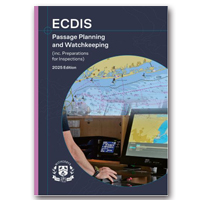제품상세보기
ECDIS PASSAGE PLANNING AND WATCHKEEPING
(INC. PREPARATIONS FOR INSPECTIONS)
Utilising the APEM (appraisal, planning, execution and monitoring) methodology, this 2025 edition sets out procedures for the correct configuration of ECDIS and highlights the best practices for passage planning and watchkeeping.
This edition of 'ECDIS Passage Planning and Watchkeeping' sets out procedures for the correct configuration of ECDIS and, utilising the appraisal, planning, execution, monitoring (APEM) methodology, highlights best practices for passage planning and watchkeeping.
An ECDIS operator should:
- Be proficient in setting up the ECDIS, particularly the safety and display settings
- be aware that, while ECDIS may continuously display a 'position', it is important to understand how that position has been derived and how to verify its accuracy. The key to effective ECDIS navigation is 'position verification' of the current global navigation satellite system (GNSS) position. The watchkeeper must regularly verify the GNSS position with lines of position (LOPs) derived from an alternative positioning method.
Practising the use of every function and technique available on the ECDIS is one of the most effective ways a watchkeeper can maintain and develop their navigation skills at sea. Learning how to use each type of ECDIS thoroughly, and mentoring others to do the same, contributes towards safer ship operation and a more effective bridge team.
In November 2021, the UK Supreme Court reaffirmed the decision that a defective passage plan effectively renders the ship legally unseaworthy. In the case in question, a large container ship went aground. The company was held liable for several million dollars when it was determined that the chart had not been properly updated. It was found that the passage plan (appraisal and planning stages) and subsequent navigation outside a buoyed fairway did not reflect a warning given in a Notice to Mariners. The warning stated that the depths shown on the chart outside the fairway were unreliable and that the waters were shallower than those recorded on the chart.





